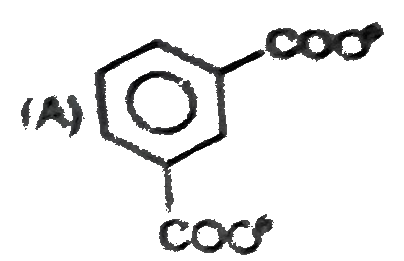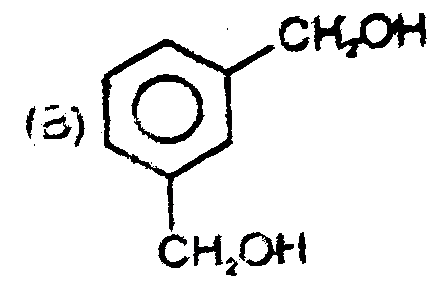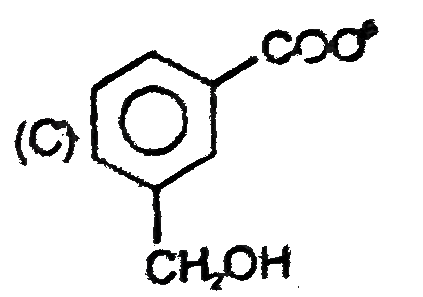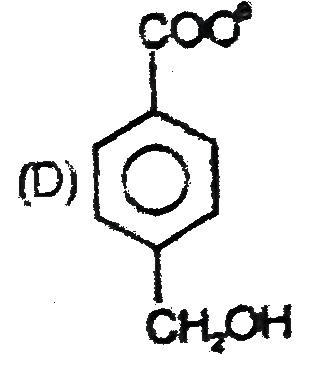When Benzene-1,3-dicarbaldehyde react with 50% NaOH.The products formed is/are :




The correct Answer is:A,B,C
To solve the problem of what products are formed when benzene-1,3-dicarbaldehyde reacts with 50% NaOH, we can follow these steps:
Step 1: Identify the structure of benzene-1,3-dicarbaldehyde
Benzene-1,3-dicarbaldehyde has two aldehyde groups (-CHO) attached to the benzene ring at the 1 and 3 positions. The structure can be represented as follows:
O||C6H4−C−C−H||O
Step 2: Understand the reaction type
The reaction of benzene-1,3-dicarbaldehyde with a strong base like NaOH is known as the Cannizzaro reaction. This reaction occurs with non-enolizable aldehydes, where one aldehyde group is oxidized to a carboxylic acid while the other is reduced to an alcohol.
Step 3: Determine the products
In the Cannizzaro reaction, since there are two aldehyde groups, we can expect multiple products due to the possibility of both inter- and intramolecular reactions.
1. Both aldehyde groups oxidized: This will yield sodium salt of a dicarboxylic acid.
- Product: COO⁻ Na⁺ (sodium salt of a carboxylic acid)
2. One aldehyde group oxidized, one reduced: This will yield one alcohol and one sodium salt of a carboxylic acid.
- Product: One position will have CH2OH (benzyl alcohol) and the other will have COO⁻ Na⁺.
3. Both aldehyde groups reduced: This will yield a diol.
- Product: Both positions will have CH2OH (benzyl alcohol).
Step 4: List all possible products
From the above reactions, we can summarize the products formed:
1. Sodium salt of dicarboxylic acid (COO⁻ Na⁺)
2. One benzyl alcohol (CH2OH) and one sodium salt of a carboxylic acid (COO⁻ Na⁺)
3. Two benzyl alcohols (CH2OH)
Final Answer:
The products formed when benzene-1,3-dicarbaldehyde reacts with 50% NaOH are:
1. Sodium salt of dicarboxylic acid
2. Benzyl alcohol and sodium salt of a carboxylic acid
3. Two benzyl alcohols
Benzene-1,3-dicarbaldehyde has two aldehyde groups (-CHO) attached to the benzene ring at the 1 and 3 positions. The structure can be represented as follows:
The reaction of benzene-1,3-dicarbaldehyde with a strong base like NaOH is known as the Cannizzaro reaction. This reaction occurs with non-enolizable aldehydes, where one aldehyde group is oxidized to a carboxylic acid while the other is reduced to an alcohol.
In the Cannizzaro reaction, since there are two aldehyde groups, we can expect multiple products due to the possibility of both inter- and intramolecular reactions.
- Product: COO⁻ Na⁺ (sodium salt of a carboxylic acid)
- Product: One position will have CH2OH (benzyl alcohol) and the other will have COO⁻ Na⁺.
- Product: Both positions will have CH2OH (benzyl alcohol).
From the above reactions, we can summarize the products formed:
1. Sodium salt of dicarboxylic acid (COO⁻ Na⁺)
2. One benzyl alcohol (CH2OH) and one sodium salt of a carboxylic acid (COO⁻ Na⁺)
3. Two benzyl alcohols (CH2OH)
The products formed when benzene-1,3-dicarbaldehyde reacts with 50% NaOH are:
1. Sodium salt of dicarboxylic acid
2. Benzyl alcohol and sodium salt of a carboxylic acid
3. Two benzyl alcohols
Topper's Solved these Questions
Similar Questions
When P4 reacts with HNO3 products formed is/are:
View SolutionWhen POCl3 reacts with H2O products formed is/are:
View SolutionWhen SOCl2 reacts with H2O products formed is/are:
View SolutionWhen boron is fused with NaOH, products formed are:
View SolutionWhen PCl5 reacts with SO2 products formed is/ are;
View SolutionOn reacting chloral hydrate with NaOH the products obtained is/are:
View SolutionWhen HNO3 reacts with P4O10 products formed is/are:
View SolutionWhen acetic acid reacts with ketene , product formed is :
View SolutionWhen PCl5 reacts with P5O10, the products formed are
View SolutionWhen propanamide is reacted with Br2 and NaOH, the product formed is :
View Solution

